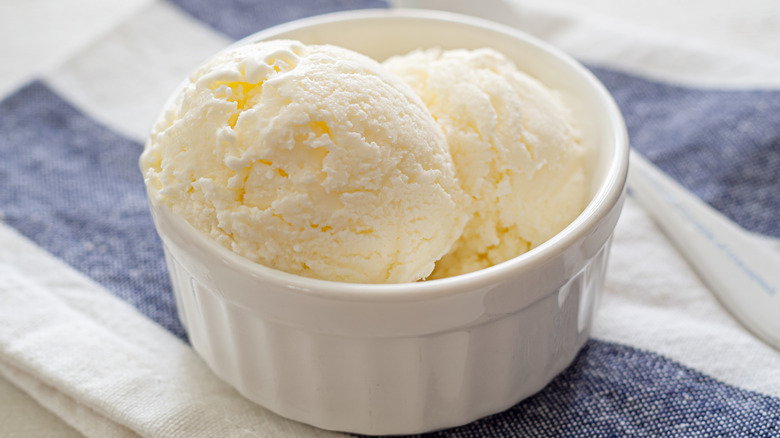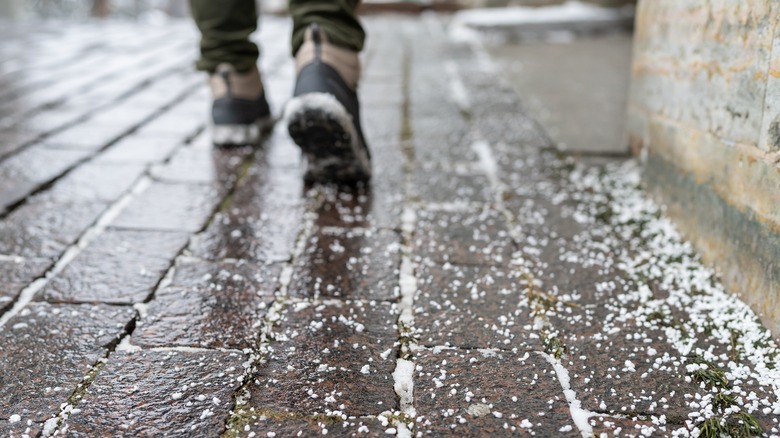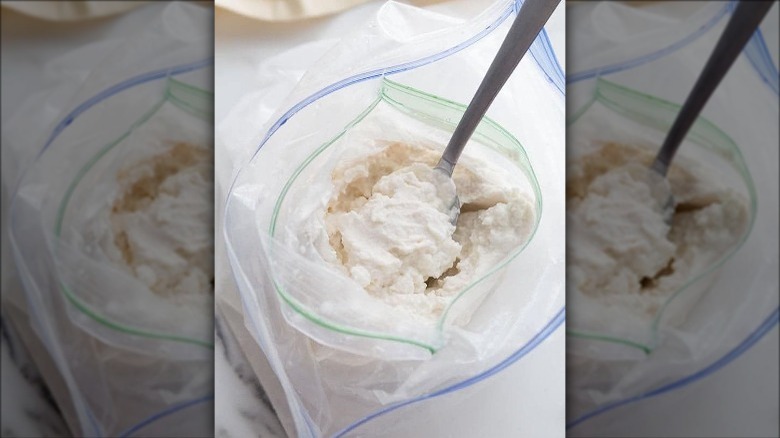Make Homemade Ice Cream In A Bag The Better Way With This Special Salt
When you look at the ingredients list for homemade ice cream in a bag, most of them make sense to the logical human brain: milk or half-and-half, sugar, the flavorings of your choice, and ice? Yep. All that makes sense. Rock salt? Nope. Not so much. The plastic bag you place inside the coffee can? Ditto. Why do you need both the bag AND the can for heaven's sake? Despite some of the parts of this equation seeming illogical, all components play a role when you're making ice cream without an ice cream maker. It comes down to science.
Let's start with the contents of the bag because they're the reason you need rock salt and the coffee can. (More on that in a minute.) Recipes will vary, but roughly, you're looking at a pint of milk (or substitute half-and-half), a quarter cup of sugar, and vanilla and other flavorings. All of this goes into a large zip-top freezer bag. This is placed inside a #10 coffee can that's filled with ice and rock salt.
Once you top this with the lid, the roll-the-coffee-can game commences. To make this easier, you can roll the can back and forth between a couple of people. Keep it moving for 15 to 20 minutes. Once that time has passed, peek in at the ice cream to see if it's solid. If not, add some more ice and rock salt to the mix and keep going until the ice cream is done.
The freezing point of ice vs. ice cream
It's likely that one of the last things that comes to mind when you're making homemade ice cream in a bag are the icy roads of winter, and yet, both have one important substance in common: rock salt. If you've ever been tempted to try making homemade ice cream without adding salt to the ice, reconsider this stance. Without this savory substance, the freezing point of the water wouldn't get low enough to freeze the ice cream.
The freezing point of fresh water is 32 degrees Fahrenheit. The freezing point for most ice creams is around 27 degrees Fahrenheit. The four-point difference arises from the fat and sugar content in the dairy you use to make the ice cream. They lower the freezing point of your frozen dessert, which is why your homemade ice cream fails when you try to freeze it with just ice that hasn't been treated with rock salt.
When you add rock salt to the ice, the salt changes the chemical make-up of the water. In short, the more salt you add to the ice, the more difficult it is to freeze. In other words, even though the salt water is melting as you make the ice cream, it's actually colder than 32 degrees Fahrenheit. Ironically, that's also why putting rock salt on the street works in the winter time. It lowers the melting point of the snow so that ice can't form on the roads.
The role of thermodynamics, air, and other stuff
After that, thermodynamics comes into play. It's actually the warmth from the ingredients in the ice cream that melts the ice, not the rock salt. According to the second law of thermodynamics, heat always moves from an object with a higher temperature — the ice cream ingredients — and moves into something at a lower temperature — the salty ice — and does so until the temperatures of each equalizes, ideally anyway.
Additionally, some brands of ice cream have a volume that's up to 50% air, which in commercial settings comes with big machines that whip the ice cream up. Home gourmands have to figure out another way to up the air content in the ice cream. That's the purpose of the coffee can and why you roll it back and forth when you make homemade ice cream. And you just thought it was for fun.
Finally, you may wonder why most people use rock salt instead of table salt when they're making ice cream. The truth is, any salt will do. However, rock salt is typically cheaper than table or kosher salt. The same amount of salt is required to make the chemical reaction work, regardless of price. Look at it this way, if you're going to spend some serious dough on homemade ice cream, it might as well be spent on ice cream upgrades, like Oreo cookies or Skittles, instead of the rock salt, the stuff that ice-free winter roads are made of.


